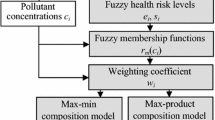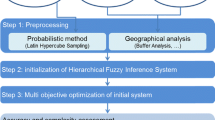Abstract
High concentrations of air pollutants in the ambient environment can result in breathing problems with human communities. Effective assessment of health-impact risk from air pollution is important for supporting decisions of the related detection, prevention, and correction efforts. However, the quality of information available for environmental/health risk assessment is often not satisfactory enough to be presented as deterministic numbers. Stochastic method is one of the methods for tackling those uncertainties, by which uncertain information can be presented as probability distributions. However, if the uncertainties can not be presented as probabilities, they can then be handled through fuzzy membership functions. In this study, an integrated fuzzy-stochastic modeling (IFSM) approach is developed for assessing air pollution impacts towards asthma susceptibility. This development is based on Monte Carlo simulation for the fate of SO2 in the ambient environment, examination of SO2 concentrations based on the simulation results, quantification of evaluation criteria using fuzzy membership functions, and risk assessment based on the combined fuzzy-stochastic information. The IFSM entails (a) simulation for the fate of pollutants in ambient environment, with the consideration of source/medium uncertainties, (b) formulation of fuzzy air quality management criteria under uncertain human-exposure pathways, exposure dynamics, and SPG-response variations, and (c) integrated risk assessment under complexities of the combined fuzzy/stochastic inputs of contamination level and health effect (i.e., asthma susceptibility). The developed IFSM is applied to a study of regional air quality management. Reasonable results have been generated, which are useful for evaluating health risks from air pollution. They also provide support for regional environmental management and urban planning.











Similar content being viewed by others
Abbreviations
- σ y and σ z :
-
point source dispersion parameters, denoting standard deviations of lateral and vertical concentration distributions (m)
- BMR D :
-
the basal metabolic rate of SPGs-D (MJ/day)
- BMR N :
-
the basal metabolic rate of SPG-N (MJ/day)
- C D :
-
the most suitable SO2 standard level for SPG-D (μg/m3)
- C N :
-
the most suitable SO2 standard level for SPG-N (N is group number, μg/m3)
- D :
-
decay term of ISC short term model
- f LC :
-
associated probability density function
- h e :
-
plume (or effective stack) height (m)
- h s :
-
physical stack height (m), and Δh is plume rise (m)
- K :
-
a scaling coefficient to convert calculated concentrations to desired units (default value of 1 × 106 for Q in g/s and concentration in μg/m3)
- P F :
-
risk level quantified as probability of system failure
- Q :
-
pollutant emission rate (mass per unit time)
- V :
-
vertical term of ISC short term model
- x :
-
downwind distance (m)
- Z i :
-
mixing height (m)
- Z r :
-
receptor height above ground (flagpole) (m)
- μs :
-
wind speed (m/s) at the release height
- Ψ:
-
the decay coefficient (s−1) (a value of zero means decay is not considered)
References
Batchelor B, Vishwanathan A, Juan V (1998) Stochastic risk assessment of sites contaminated by hazardous wastes. J Environ Eng 124(4):0–390
Byun DW, Kim ST, Cheng FY, Kim SB, Cuclis A, Moon NK (2003) Information infrastructure for air quality modeling and analysis: application to the Houston–Galveston ozone non-attainment area. J Environ Info 2(2):38–57
Chen Z, Huang GH, Chakma A (1998a) Numerical modeling of soil and groundwater contamination: subsurface hydrology and advanced modeling for petroleum-contaminated sites, vol 2. Technical Report, Prepared for Faculty of Engineering, University of Regina, Regina, Canada
Chen Z, Huang GH, Chakma A, Tontiwachwuthikul P (1998b) Environmental risk assessment for aquifer disposal of carbon dioxide. In: Proceedings of fourth international conference on greenhouse gas control technologie. Interlaken, Switzerland
Chen Z, Huang GH, Chakma A (1998c) Integrated environmental risk assessment for petroleum-contaminated sites—a North American case study. Water Sci Technol 38(4–5):131–138
Chen Z, Huang GH, Chakma A (2000) Risk assessment of a petroleum-contaminated site through a multi-phase and multi-component modeling approach. J Pet Sci Eng 26(1–4):273–281
Chen B, Huang GH, Li YF (2005) Pesticide-loss simulation and health risk assessment during the flood season in watershed systems. Water Int 30(1):88–98
Christakos G, Vyas V (1998) A novel method for studying population health impacts of spatiotemporal ozone distribution. Soc Sci Med D Med Geogr 47(8):1051–1066
Christakos G, Kolovos A (1999) A study of the spatiotemporal health impacts of ozone exposure. J Expo Anal Environ Epidemiol 9(4):322–335
Christakos G, Serre ML (2000) A spatiotemporal study of exposure-health effect associations. J Expo Anal Environ Epidemiol 10(2):168–187
Civanlar MR, Trussel HJ (1986) Constructing membership functions using statistical data. Fuzzy Sets Syst 18:1–13
Derek SA (1996) Managing Urban air quality. Earthscan Publications Limited, London, pp 3–48
Dou C, Woldt W, Bogardi I, Dahab M (1995) Steady state groundwater flow simulation with imprecise parameters. Water Resour Res 31(11):2709–2719
Dou C, Woldt W, Bogardi I, Dahab M (1997) Numerical solute transport simulation using fuzzy sets approach. J Contam Hydrol 27:107–126
Dubois D, Prade H (1986) Fuzzy sets and statistical data. Eur J Operat Res 25:345–356
Folinsbee L (1992) Human health effects of air pollution. Environ Health Perspect 100:47–48
Fowler MG, Davenport MG, Garg R (1992) School functioning of US children with asthma. Pediatrics 90:939–44
Freissinet C, Vauclin M, Erlich M (1999) Comparison of first-order analysis and fuzzy set approach for the evaluation of imprecision in a pesticide groundwater pollution screening model. J Contam Hydrol 37:21–34
Horstman DH (1988) The relationship between exposure duration and sulphur dioxide induced bronchoconstriction in asthmatic subjects. Am Ind Hyg Assoc J 49:38–47
Kaufmann A, Gupta MM (1991) Introduction a fuzzy arithmetic: theory and applications. Van Nostrand Reinhold, New York
Kontos A, Fassois S, Deli M (1999) Short-term effects of air pollution on childhood respiratory illness in Piraeus, Greece, 1987–1992: nonparametric stochastic dynamic analysis. Environ Res 81(4):275–297
Lawther PJ (1975) Pulmonary function and sulfur dioxide, some preliminary findings. Environ Res 10:355–367
Lee YW, Dahab MF, Bogardi I (1995) Nitrate-risk assessment using fuzzy-set approach. J Environ Eng 121:245–256
Leung Y (1988) Spatial analysis and planning under imprecise. Elesevier, New York
Li JB, Huang GH, Chakma A, Zeng GM (2003) Integrated Fuzzy-Stochastic Modeling of Petroleum Contamination in Subsurface. Energy Sources 25(6):547–564
Li JB, Huang GH, Zeng GM (2007) An integrated fuzzy-stochastic modeling approach for risk assessment of groundwater contamination. J Environ Manage 82(2):173–188
Liu L, Hao RX, Cheng SY (2003) A possibilistic analysis approach for assessing environmental risks from drinking groundwater at petroleum-contaminated sites. J Environ Info 2(1):31–37
Linn WS (1987) Replicated dose–response study of sulfur dioxide effects in normal, atopic and asthmatic volunteers. Am Rev Respir Dis 136:1127–1134
Luo B, Yin YY, Huang GH, Huang YF (2004) Uncertainty analysis for distribution of greenhouse gases concentration in atmosphere. J Environ Info 3(2):89–94
Maqsood I, Li JB, Huang GH (2005) Simulation-based risk assessment of contaminated sites under remediation scenarios, planning periods, and land-use patterns—a Canadian case study. Stoch Environ Res Risk Assess 19(2):146–157
Morel B, Yeh S, Cifuentes L (1999) Statistical distributions for air pollution applied to the study of the particulate problem in Santiago. Atmos Environ 33:2575–2585
Milionis AE, Davies TD (1994) Regression and stochastic models for air pollution—-II. Application of stochastic models to examine the links between ground-level smoke concentrations and temperature inversions. Atmos Environ 28(17):2811–2822
Nadel JA (1965) Mechanism of bronchoconstriction during inhalation of sulfur dioxide. J Appl Physiol 20:164–167
Oettl D,Almbauer RA, Sturm PJ (2003) Pretterhofer, G. Dispersion modelling of air pollution caused by road traffic using a Markov Chain–Monte Carlo model. Stoch Environ Res Risk Assess Res J 17(1):58–76
Perera LAK, Achari G, Hettiaratchi JPA (2004) An assessment of the spatial variability of greenhouse gas emissions from landfills: a GIS based statistical–numerical approach. J Environ Info 4(1):11–30
Pesti G, Shrestha BP, Duckstein L, Bogardi I (1996) A fuzzy rule-based approach to drought assessment. Water Resour Res 32:1741–1747
Peters A (1996) Acute effects of exposure to high levels of air pollution in Eastern Europe. Am J Epidemiol 144(6):570–580
Rubin Y, Cushey MA, Bellin A (1994) Modeling of transport in groundwater for environmental risk assessment. Stoch Hydrol Hydraul 8(1):57–67
Shen ZY, Ding XW, Yang ZF (2004) Construction of plan environmental impact assessment system in China. J Environ Info 4(2):75–81
Smith PN (1995) Environmental evaluation: fuzzy impact aggregation. J Environ Syst 24(2):191–204
Sunyer J (1996) Air pollution and mortality in Barcelona. J Epidemiol Commun Health 50(1):S76
Touloumi G, Samoli E, Katsouyanni K (1996) Daily mortality and ‘Winter type’ air pollution in Athens, Greece: a time series analysis within the APHEA project. J Epidemiol Commun Health 50(1):S47
Turksen IB (1986) Measurement of membership functions. Applications of fuzzy set theory in human factors. Elsevier, Amsterdam
Turksen IB (1991) Measurement of membership functions and their acquisition. Fuzzy Sets Syst 40(1):5–34
US Environmental Protection Agency (USEPA) (1989) Exposure factors handbook. Office of Research and Development, Office of Health and Environmental Assessment, Washington, DC, EPA/600/18-89/043
US Environmental Protection Agency (USEPA) (1992) Guidelines for exposure assessment. Office of Research and Development, Office of Health and Environmental Assessments, Washington, DC, EPA/600/Z-92/001
US Environmental Protection Agency (USEPA) (1994) Methods for derivation of inhalation reference concentrations and application of inhalation dosimetry. Office of Research and Development, Office of Health and Environmental Assessment, Washington, DC, EPA/600/8-90/066F
US Environmental Protection Agency (USEPA) (1995) User’s Guide for The Industrial Source Complex (ISC3) Dispersion Models Office of Air Quality Planning and Standards Emissions. Monitoring, and Analysis Division Research Triangle Park, North Carolina 27711
Veiga MM (1995) An adaptive fuzzy model for risk assessment of mercury pollution in the amazon. In: Proceedings of 1995 IEEE international conference on systems, Man and Lybernetics. Vancouver, BC, Canada
Vigotti M (1996) Short-term effects of urban air pollution on respiratory health in Milan, Italy, 1980–1989. J Epidemiol Commun Health 50(1):S71
Vyas V, Christakos G (1997) Spatiotemporal analysis and mapping of sulfate deposition data over the conterminous USA. Atmos Environ 31(21):3623–3633
Weiss KB, Sullivan SD, Lyttle CS (2000) Trends in the cost of asthma in the United States. Allergy Clin Immunol 106:493–9
World Health Organization (WHO) (2000) Air quality guidelines, 2nd edn. WHO Regional Office for Europe, Copenhagen
Zadeh LA (1965) Fuzzy sets. Inf Control 8:29–44
Zimmermann HJ (1991) Fuzzy set theory and its applications, 2nd edn. Kluwer, Dordrecht
Zou Y, Li J, Huang GH, Li HL (2002) An inexact air quality model for petroleum pollutants based on techniques of factorial analysis and stochastic simulation. In: SPE international thermal operations and heavy oil symposium and international horizontal well technology conference. Calgary, Canada
Acknowledgments
The authors are grateful to the editor and the anonymous reviewers for their insightful comments and suggestions. The authors would like to thank for their technical assistance. Thanks are also due to Mr. S. Podwin of SaskPower, Saskatchewan, Canada and Drs. Z. Chen and J.B. Li of the Environmental Informatics Laboratory, University of Regina for their technical assistances. This research was supported by the Major State Basic Research Development Program (2005CB724200 and 2006CB403307).
Author information
Authors and Affiliations
Corresponding author
Rights and permissions
About this article
Cite this article
Li, H.L., Huang, G.H. & Zou, Y. An integrated fuzzy-stochastic modeling approach for assessing health-impact risk from air pollution. Stoch Environ Res Risk Assess 22, 789–803 (2008). https://doi.org/10.1007/s00477-007-0187-1
Published:
Issue Date:
DOI: https://doi.org/10.1007/s00477-007-0187-1




